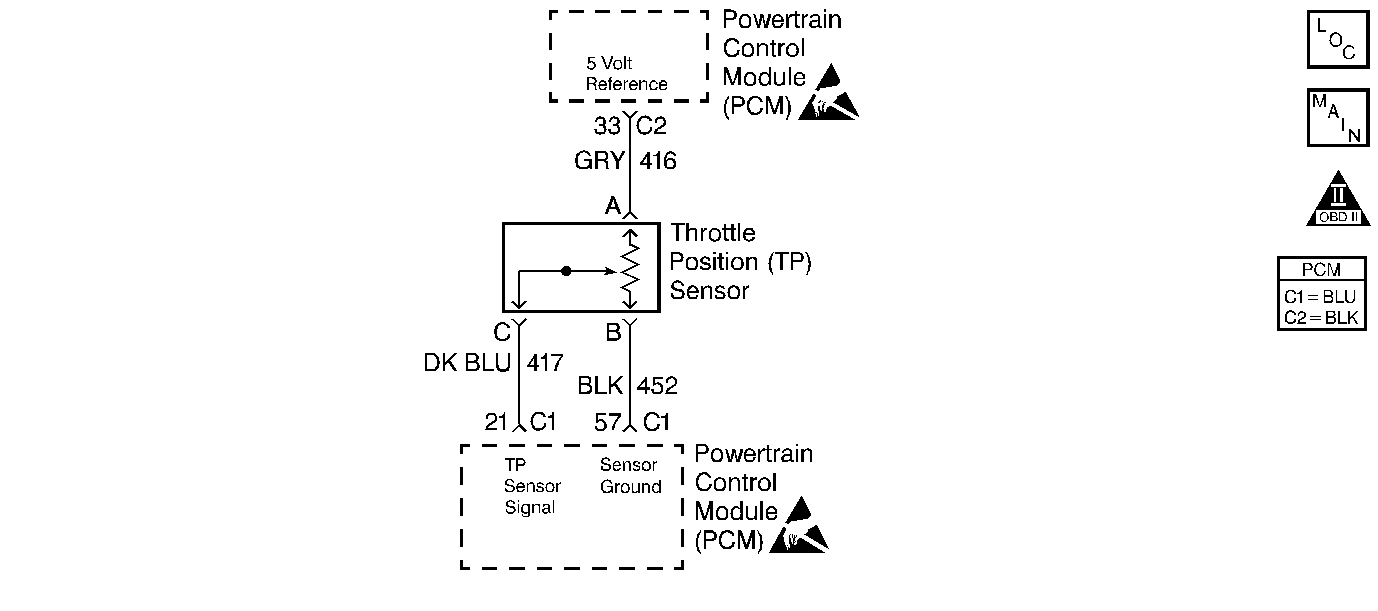
Circuit Description
The TP sensor is a 3 wire variable resistor called a potentiometer. The PCM supplies a 5.0 volt reference, a signal and a ground circuit to the sensor. The TP sensor sends a voltage signal back to the PCM relative to the throttle plate opening. The voltage will vary from approximately 0.35 volts at closed throttle, to over 4.65 volts at wide open throttle.
Conditions For Running The DTC
The engine is running.
Conditions for Setting the DTC
The TP sensor reads less than 0.10 volts for 6.25 seconds.
Action Taken When the DTC Sets
| • | The malfunction indicator lamp (MIL) illuminates after 2 consecutive ignition cycles with the malfunction present. |
| • | The PCM records the operating conditions at the time the diagnostic fails. This information will be stored in the Freeze Frame and Failure Records buffers stores this information. |
| • | A history DTC is stored. |
| • | The TP angle will default to 0 percent when the vehicle speed is less than 2 mph. The TP angle defaults to 10 percent when the vehicle speed is more than 2 mph. The scan tool shows the defaulted value. |
Conditions for Clearing the MIL/DTC
| • | The MIL will turn OFF after 3 consecutive ignition cycles in which the diagnostic runs without a fault. |
| • | A history DTC will clear after 40 consecutive warm up cycles without a fault. |
| • | A scan tool can clear the DTCs. |
Diagnostic Aids
The TP should read about 0.45 volts to 0.85 volts with the throttle closed and the ignition ON or at idle. The voltage should increase at a steady rate as the throttle is moved toward wide open throttle (WOT). An open or short in the 5 volt reference or the signal wire results in a DTC P0122. Scan the TP sensor while depressing the throttle with the engine OFF and the ignition ON. The voltage should vary from below 1.25 volts to over 4.5 volts with the throttle at WOT.
Whenever this DTC cannot be duplicated, use the information included in the Freeze Frame data in order to evaluate the conditions when the DTC set. Thoroughly check any circuits or components suspected of causing an intermittent. Refer to Testing for Intermittent Conditions and Poor Connections in Wiring Systems for information on testing.
A faulty A/C sensor or fuel tank pressure sensor could set a DTC P0122. Disconnect the A/C electrical connector or the fuel tank pressure sensor. If the TP reading returns to normal, diagnose the sensor that caused the low voltage condition.
Test Description
The numbers below refer to the step numbers on the diagnostic table.
-
The Powertrain OBD System Check prompts you to complete some of the basic checks and to store the Freeze Frame and Failure Records data on the scan tool if applicable. This creates an electronic copy of the data captured when the malfunction occurred. The scan tool stores this data for later reference.
-
The TP sensor has an auto zeroing feature. If the voltage reading is between 0.20 volts and 0.90 volts, the PCM will automatically assume this as a closed throttle position (0 percent).
-
This simulates a DTC P0123. If the PCM recognizes the high voltage signal, this indicates that the PCM and the wiring are OK.
-
This simulates a high voltage signal which will identify an open in the signal circuit.
-
If the test lamp illuminates while probing the TP signal circuit terminal in step 5, then the TP signal circuit is shorted to ground.
-
Reprogram the replacement PCM and perform the Crankshaft Position System Variation Learn Procedure. Refer to the latest Techline information for PCM programming.
Step | Action | Values | Yes | No | ||||||||
|---|---|---|---|---|---|---|---|---|---|---|---|---|
Did you perform the Powertrain On-Board Diagnostic (OBD) System Check? | -- | |||||||||||
Is the TP sensor voltage below the specified value? | 0.2 V | |||||||||||
3 |
Is the TP sensor voltage below the specified value? | 0.2 V | Go to Diagnostic Aids | |||||||||
Is the TP sensor voltage more than the specified value? | 4.0 V | |||||||||||
Connect a test lamp between B+ and the TP sensor signal circuit at the TP harness connector. Is the TP sensor voltage more than the specified value? | 4.0 V | |||||||||||
6 |
Was a repair necessary? | -- | ||||||||||
7 |
Was a repair necessary? | -- | ||||||||||
Was a repair necessary? | -- | |||||||||||
9 |
Was a repair necessary? | -- | ||||||||||
10 |
Is the action complete? | -- | -- | |||||||||
|
Important: The replacement PCM must be programmed. Replace the PCM. Refer to Powertrain Control Module Replacement/Programming . Is the action complete? | -- | -- | ||||||||||
12 |
Does the scan indicate that this diagnostic Ran and Passed? | -- | ||||||||||
13 | Check to see if any additional DTCs are set. Does the scan tool display any DTCs that you have not diagnosed? | -- | Go to applicable DTC table | System OK |
